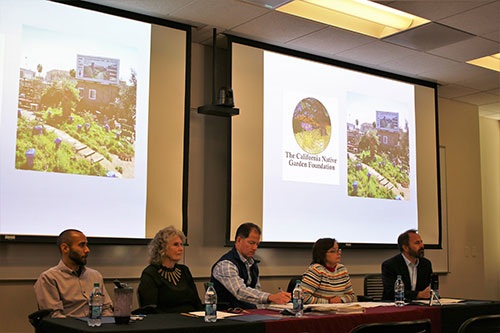
On Thursday, Nov. 3rd, Santa Clara University hosted a panel discussion on the newest housing community – a 6-acre site located at 70 Winchester described as an “environmentally and economically sustainable approach for urban development.” Bill Mains, the Director of Sustainability Programs in the Leavey School of Business, and Katharine Rondthaler, the Manager of SCU’s Forge Garden introduced the panelists – Vince Cantore, Senior Development Manager of the CORE Companies; Teresa O’Neill, Santa Clara’s Vice Mayor; Dorsey Moore, Chairman of the Board of the Open Space Authority Santa Clara Valley; Alrie Middlebrook, President of the California Native Garden Foundation; and Dr. William Armaline, Human Rights Director at SJSU’s Department of Justice Studies.
The proposed “Agrihood” – located across the street from Valley Fair Shopping Center – was once part of a 17-acre agricultural research center last owned by the State of California. Vice Mayor O’Neill explained that state budget woes around the early 2000s forced the state to sell the land, but the city of Santa Clara could only afford through the Redevelopment Fund to purchase six of the open space acres. Then, during a contentious period in the city’s history, 11 of the acres were developed into housing. Santa Clara, however, didn’t have enough funds at the time to develop their acreage. Eventually, as the economy recovered, the city realized they needed “shovels in the ground” by January 2017 or the state could potentially retake the land. The city selected the CORE Companies’ proposal because they were most willing to look into creative possibilities for the acres.
Cantore of the CORE Companies added that their “Agrihood” plan was developed after a series of community meetings and feedback. The “medium density, low income senior [and veteran], affordable and market rate housing community” is already unique but then there’s the four part innovative aspect: a market plaza for potential mini farmer’s markets; a community center / barn that could include a kitchen for cooking classes and an exhibit space; a community garden; and urban agriculture space that could feature row crops and demonstration projects.
CORE representatives revealed during the panel’s Q&A session that the company is also exploring options such as having a “Farmer in Residence” living in one of the housing units, a new parking system that could include car sharing and community bicycles, and green roofs. However, Cantore defined their main goal as ensuring the “Agrihood” offers a “link between the Santa Clara urban lifestyle and the agricultural past.”
But CORE isn’t the only organization involved. Instead, as Middlebrook revealed, a new proposed institute, “The Sustainable Urban Land Research Institute” (SLURI) would be located on site. SLURI – a collaboration between Santa Clara County’s participating cites, the California Native Garden Foundation, SJSU, SCU, Stanford and UCSC – hopes to work with a large network of “allied farm to table partners” to explore a “local food system model.” But SLURI also hopes to return the space back to agricultural research through 10 key research and development categories along with monitoring and reporting on healthy urban land use models.
Moore offered his input, stating that while the Open Space Authority will be supporting the project although it’s not directly in his district, it’s equally important to involve current students in the research. As he remarked, “we need to invest in creating the next generation of environmental stewards.”
Dr. Armaline of SJSU couldn’t agree more. Armaline stressed that we are sitting on an unsustainable bubble of an economy in Silicon Valley, particularly in regards to housing. He believed that these new development projects should consider economic and social sustainability as well as ecological notions of local, slow-food systems to create tight-knit autonomous communities.
Perhaps all of these goals for the project were best summed up by O’Neill who lived near the “Agrihood” site as a child. She fondly remembered visiting the research “oasis” to catch and study bugs in jars with her mom.
“We have enough buildings,” O’Neill stated, “we are choking on congestion. […] We need a connection to the earth again.”
She hopes that the farm and community garden will bring a positive impact not only to the residents of the site but also to the larger city as well. O’Neill knows that Santa Clara has a lot of work to do on “visioning” the next projects but sees the CORE plan as a good prototype.
“It’s like in Gone with the Wind,” O’Neill said, “Like Gerald O’Hara reminded his daughter, ‘hold onto the land’ so I tell people, ‘Remember Tara.’ We need to take care of the land we come from.”






Agri-Home in Santa Clara is a welcome housing development. I’m especially hoping I can score one
of the Senior housing. How can I apply to be one of the lucky residents. I’ve been trying to contact
Agri-Home, but has not received any response on how to apply for a housing unit. Can you help, please?
Thank you,
RDUngstad